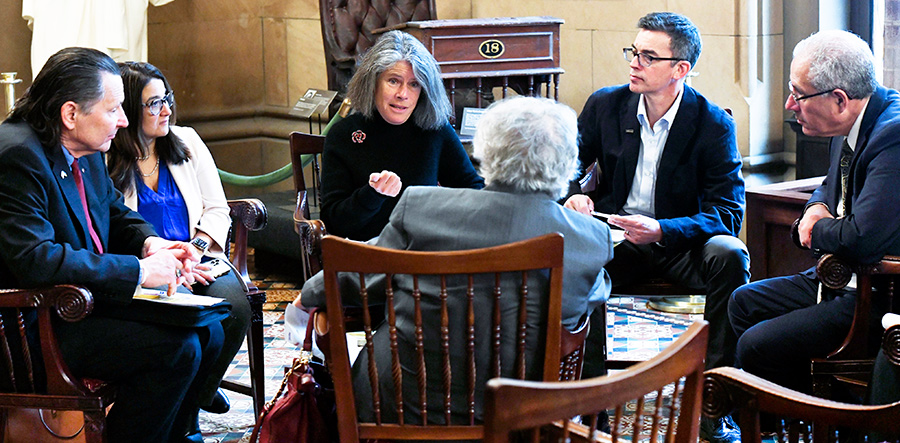NYSUT praises full Foundation Aid plan; calls for other crucial funding
hile praising the executive budget’s historic commitment to Foundation Aid, NYSUT President Andy Pallotta urged lawmakers to add funding for several crucial initiatives to help schools cope with the pandemic’s lingering effects and severe staffing shortages.
In K-12 testimony before the legislative budget committees, Pallotta noted much of the good news in the governor’s budget plan was overshadowed by a disturbing plan to expand corporate charter schools. A number of lawmakers voiced concerns that charter schools are not accountable, cherry-pick students and siphon funding from traditional public schools. NYSUT has also unveiled its “New Deal for Higher Education” campaign calling for a significant investment in SUNY, CUNY and community college campuses. (See page 14.)
On K-12 education funding, Pallotta thanked lawmakers for their partnership to fully fund school aid, with a 10 percent statewide increase. “This will make a real difference around the state,” he said.

El-Wise Noisette
However, he was quick to add that public schools will need additional resources to provide a much wider array of services — from mental health to nutrition to ensuring that students have access to quality social-emotional learning.
Pallotta put in a big plug to expand community schools. While the executive budget continues to provide $250 million in community school funding as a set-aside in Foundation Aid, NYSUT is advocating for an additional $100 million in categorical funding — separate from Foundation Aid — to expand the number of community schools and support the hiring of community school directors.
According to State Education Department data, less than 2 percent of school districts have a community school director. In New York City, United Federation of Teachers data shows that a $100,000 investment to hire a community school director can bring in more than $600,000 in services and grants to the school community. In Central New York, a network of community schools reports a $14 return on every dollar invested.
Another important item missing from the budget is universal free school meals. In June, federal waivers ensuring every student in the nation had access to free school meals expired. “As a result, more than 726,000 students in New York state have lost access to free school meals,” Pallotta said. “Studies show hunger hinders a student’s ability to learn and can lead to behavior and attendance problems. This is a big priority for us.”
Pallotta also urged restoration of $21.4 million for the state’s network of teacher centers. These centers provide many programs to support teachers, School-Related Professionals and parents. He noted teacher centers have focused on creating programming that addresses the trauma and stress of the pandemic, as well as the social-emotional well-being of students, parents, caregivers, teachers and school staff.
He also called for legislators to reject the executive budget’s $2 million cut for the state’s schools for the blind, deaf and severely disabled. In addition, he urged lawmakers to provide significant funding to attract and retain the educators and therapists needed in the state’s Special Act, 853 and 4201 Schools, as well as 4410 programs serving students with medical, behavioral and other special needs around the state.
While the executive budget proposes full funding of BOCES, Pallotta said more needs to be done to expand access to Career and Technical Education programs. He said the current aid formula for BOCES CTE programs has not changed since 1990 and the state only provides aid for the first $30,000 of a BOCES instructor’s salary. Covering a more reasonable share would encourage school districts to send more students to BOCES CTE programs.
Finally, Pallotta encouraged lawmakers to double state funding for the union-led implicit bias training, with a goal of providing professional learning to every member of NYSUT.
In addition to the testimony at legislative hearings, NYSUT advocates will be meeting with lawmakers throughout the spring with a number of lobby days, including the union’s Committee of 100 in March. The budget is due April 1.